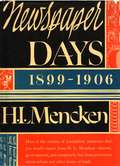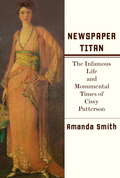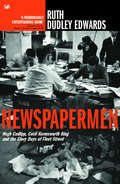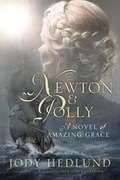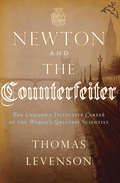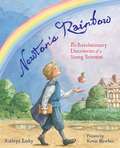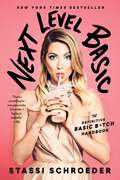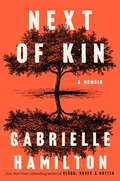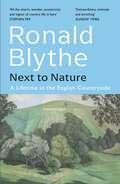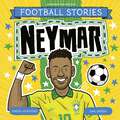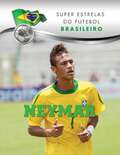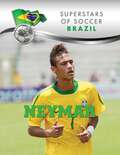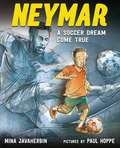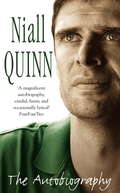- Table View
- List View
Newsmaker: Roy W. Howard, the Mastermind Behind the Scripps-Howard News Empire From the Gilded Age to the Atomic Age
by Patricia BeardThis is the story of one of the most important American newspapermen of the twentieth century. Roy Howard rose to prominence at the height of newspapers&’ power and became a leader in the evolution of print news starting in 1908—when E. W. Scripps appointed him head of the fledgling United Press at age 25—through his tenure as chairman of the Scripps-Howard empire until 1952. As Howard expanded and modernized the business, he landed some of the most important scoops between World War I and the Korean War. Ebullient, likeable, and outgoing, he headed one of only two coast-to-coast news concerns—Hearst being the other. An advisor to presidents and prime ministers, Howard witnessed the most significant events of the time. A 1930 front-page New York Times article named him one of the 59 men who &“rule&” America, with John D. Rockefeller topping the list. Time magazine put him on the cover. The Saturday Evening Post lionized him. Even his enemies gave him plenty of coverage: The New Yorker excoriated him in a four-part series, although the author admitted that Howard&’s and Hearst&’s were the only American newspaper publishers whose photographs the average newspaper reader would recognize. With exclusive, first-time access to thousands of previously unpublished documents in the privately held Howard family archives, author Patricia Beard opens a rich mine of stories from one of the most volatile periods in history as revealed by the head of a newspaper empire at a time when the press both made and broke the news.
Newspaper Days: 1899-1906 (H.L. Mencken's Autobiography)
by H. L. MenckenOriginally published: New York: Knopf, 1941.
Newspaper Titan: The Infamous Life and Monumental Times of Cissy Patterson
by Amanda SmithThe galvanizing story of Eleanor Medill (Cissy) Patterson, celebrated debutante and socialte, scion of the Chicago Tribune empire, and the twentieth century's first woman editor in chief and publisher of a major metropolitan daily newspaper, the Washington Times-Herald. She was called the most powerful woman in America, surpassing Eleanor Roosevelt, Bess Truman, Clare Boothe Luce, and Dorothy Schiff.Cissy Patterson was from old Republican stock. Her grandfather was Joseph Medill, firebrand abolitionist, mayor of Chicago, editor in chief and principal owner of the Chicago Tribune, and one of the founders of the Republican Party who delivered the crucial Ohio delegation to Abraham Lincoln at the convention of 1860.Cissy Patterson's brother, Joe Medill Patterson, started the New York Daily News.Her pedigree notwithstanding, Cissy Patterson came to publishing shortly before her forty-ninth birthday, in 1930, with almost no practical journalistic or editorial experience and a life out of the pages of Edith Wharton (or more likely the other way around: shades of Cissy are everywhere in the Countess Olenska). Amanda Smith writes that in the summer of 1930, Cissy Patterson, educated at the turn of the century at Miss Porter's School in Farmington, Connecticut, for a vocation of marriage and motherhood and a place in society, took over William Randolph Hearst's foundering Washington Herald and began to learn what others believed she could never grasp--how to run and build up a newspaper. She vividly lived out the Medill family's editorial motto (at least in spirit): "When you grandmother gets raped, put it on the front page."Patterson soon bought from Hearst the Herald's evening sister paper, the Washington Times, merged the two, and became editor, publisher, and sole proprietor of a big-city newspaper, a position almost unprecedented in American history. The effect of the merger was "electric"...By 1945, the Washington Times-Herald, with ten daily editions, was clearing an annual profit of more than $1 million.Amanda Smith, in this huge, fascinating biography gives us the (infamous) life and monumental times of Cissy Patterson, scourge of liberals, advocate of appeasing Hitler, lover of poodles, and hater of FDR.Here is her twentieth-century Washington: its politics and society, scandals and feuds, and at the center--the fierce newspaper wars that consumed and drove the country's press titans, as Patterson took the Washington Times-Herald from a chronic tail-ender in circulation and advertising, ranked fifth in the town, and made it into the most widely read round-the-clock daily in the national's capital, deemed by many to be "the damndest newspaper to ever hit the streets."
Newspapermen: Hugh Cudlipp, Cecil Harmsworth King and the Glory Days of Fleet Street
by Ruth Dudley EdwardsThey were 'Cudlipp' and 'Mr King' when they met in 1935. At 21, gregarious, extrovert and irreverent Hugh Cudlipp had many years of journalistic experience: at 34, shy, introspective and solemn Cecil Harmsworth King, haunted by the ghost of Uncle Alfred, Lord Northcliffe, the great press magnate, and bitter towards Uncle Harold, Lord Rothermere of the Daily Mail, was fighting his way up in the family business. Opposites in most respects, they were complementary in talents and had in common a deep concern for the underdog. Cudlipp, the journalistic genius, and King, the formidable intellect, were to become, in Cudlipp's words, 'the Barnum and Bailey' of Fleet Street. Together, on the foundation of the populist Daily Mirror, they created the biggest publishing empire in the world. Yet their relationship foundered sensationally in 1968, when - as King tried to topple the Prime Minister - Cudlipp toppled King. Through the story of two extraordinary men, Ruth Dudley Edwards gives us a riveting portrait of Fleet Street in its heyday.
Newsroom Confidential: Lessons (and Worries) from an Ink-Stained Life
by Margaret Sullivan"Sullivan remains the critic American journalism requires, a veteran practitioner with street cred, still in touch with the ‘unaccountable joy’ of reporting and writing that continues to draw talented young people to the field.” —Steve Coll, The New York Times Book ReviewSullivan began her career at the Buffalo News, where she rose from summer intern to editor in chief. In Newsroom Confidential she chronicles her years in the trenches battling sexism and throwing elbows in a highly competitive newsroom. In 2012, Sullivan was appointed the public editor of The New York Times, the first woman to hold that important role. She was in the unique position of acting on behalf of readers to weigh the actions and reporting of the paper's staff, parsing potential lapses in judgment, unethical practices, and thorny journalistic issues. Sullivan recounts how she navigated the paper’s controversies, from Hillary Clinton's emails to Elon Musk's accusations of unfairness to the need for greater diversity in the newsroom. In 2016, having served the longest tenure of any public editor, Sullivan left for the Washington Post, where she had a front-row seat to the rise of Donald Trump in American media and politics.With her celebrated mixture of charm, sharp-eyed observation, and nuanced criticism, Sullivan takes us behind the scenes of the nation's most influential news outlets to explore how Americans lost trust in the news and what it will take to regain it.
Newton
by Peter AckroydThe third short biography in Peter Ackroyd’s brilliantBrief Livesseries, Newton is a companion volume to Chaucer and Turner. Sir Isaac Newton (1642-1727) is said to have made his greatest contributions to science in 1665-66 while at his parents’ home in Lincolnshire escaping the Great Plague (which had closed the universities). It was at this fruitful time that he formulated calculus, hit upon the idea of gravity and performed experiments which showed that white light was made up of different coloured rays. Newton wrote Principia, one of the most important books in the history of science, in which he proved the “laws of motion. ” He was also interested in the movements of the planets and designed his own telescope, and was as passionate about astrology as he was about astronomy. Newton dabbled in alchemy, and used the Bible to work out that the date of the earth’s creation was 3,500 B. C. Newton is a wonderful subject for a writer with Peter Ackroyd’s imagination and flair: the alchemist, the magician, the thinker light years ahead of his time. Einstein wrote of Newton: “In one person, he combined the experimenter, the theorist, the mechanic and, not least, the artist in exposition. ”
Newton and Polly: A Novel of Amazing Grace
by Jody HedlundAmazing grace! How sweet the sound that saved a wretch like me. I once was lost, but now am found...Now remembered as the author of the world's most famous hymn, in the mid-eighteenth century as England and France stand on the brink of war, John Newton is a young sailor wandering aimlessly through life. His only duty is to report to his ship and avoid disgracing his father--until the night he hears Polly Catlett's enchanting voice, caroling. He's immediately smitten and determined to win her affection.An intense connection quickly forms between the two, but John's reckless spirit and disregard for the Christian life are concerns for the responsible, devout Polly. When an ill-fated stop at a tavern leaves John imprisoned and bound, Polly must choose to either stand by his side or walk out of his life forever. Will she forfeit her future for the man she loves?Step back through the pages of history, to uncover the true love story behind a song that continues to stir the hearts and ignite the faith of millions around the globe.
Newton and the Counterfeiter: The Unknown Detective Career of the World's Greatest Scientist
by Thomas LevensonA &“thoroughly surprising&” chapter in the life of Isaac Newton, with a &“vivid re-creation of 17th-century London and its fascinating criminal haunts&” (Providence Journal). When renowned scientist Isaac Newton takes up the post of Warden of His Majesty&’s Mint in London, another kind of genius—a preternaturally gifted counterfeiter named William Chaloner—has already taken up residence in the city, rising quickly in an unruly, competitive underworld. In the courts and streets of London, and amid the tremors of a world being transformed by ideas Newton himself set in motion, Chaloner crosses paths with the formidable new warden. An epic game of cat and mouse ensues in Newton and the Counterfeiter, revealing for the first time the &“remarkable and true tale of the only criminal investigator who was far, far brainier than even Sherlock Holmes: Sir Isaac Newton during his tenure as Warden of the Royal Mint . . . A fascinating saga&” (Walter Isaacson). &“I absolutely loved Newton and the Counterfeiter. Deft, witty and exhaustively researched.&” —Junot Díaz, author of The Brief Wondrous Life of Oscar Wao &“A delicious read, featuring brilliant detective work and a captivating story . . . A virtuoso performance.&” —Sylvia Nasar, author of A Beautiful Mind &“Through a page-turning narrative, we witness Isaac Newton&’s genius grappling with the darker sides of human nature, an all too human journey reflecting his deepest beliefs about the cosmic order.&” —Brian Greene, author of The Fabric of the Cosmos &“Levenson transforms inflation and metallurgy into a suspenseful detective story bolstered by an eloquent summary of Newtonian physics and stomach-turning descriptions of prison life in the Tower of London. . . . [The book] humanizes a legend, transforming him into a Sherlock Holmes in pursuit of his own private Moriarty.&” —The Washington Post
Newton's Clock: Chaos in the Solar System
by Ivars PetersonWith his critically acclaimed best-sellers The Mathematical Toursist and Islands of Truth, Ivars Peterson took readers to the frontiers of modern mathematics. His new book provides an up-to-date look at one of science's greatest detective stories: the search for order in the workings of the solar system.In the late 1600s, Sir Isaac Newton provided what astronomers had long sought: a seemingly reliable way of calculating planetary orbits and positions. Newton's laws of motion and his coherent, mathematical view of the universe dominated scientific discourse for centuries. At the same time, observers recorded subtle, unexpected movements of the planets and other bodies, suggesting that the solar system is not as placid and predictable as its venerable clockwork image suggests.Today, scientists can go beyond the hand calculations, mathematical tables, and massive observational logs that limited the explorations of Newton, Copernicus, Galileo, Kepler, Tycho Brahe, and others. Using supercomputers to simulate the dynamics of the solar system, modern astronomers are learning more about the motions they observe and uncovering some astonishing examples of chaotic behavior in the heavens. Nonetheless, the long-term stability of the solar system remains a perplexing, unsolved issue, with each step toward its resolution exposing additional uncertainties and deeper mysteries.To show how our view of the solar system has changed from clocklike precision to chaos and complexity, Newton's Clock describes the development of celestial mechanics through the ages--from the star charts of ancient navigators to the seminal discoveries of the 17th centure; from the crucial work of Poincaré to the startling, sometimes controversial findings and theories made possible by modern mathematics and computer simulations. The result makes for entertaining and provocative reading, equal parts science, history, and intellectual adventure.
Newton's Rainbow: The Revolutionary Discoveries of a Young Scientist
by Kathryn LaskyThis book tells the story of young Isaac—always reading, questioning, observing, and inventing—and how he eventually made his way to Cambridge University, where he studied the work of earlier scientists and began building on their accomplishments. The book celebrates Newton's discoveries that illuminated the mysteries of gravity, motion, and even rainbows, discoveries that gave mankind a new understanding of the natural world, discoveries that changed science forever.
Newton: A Very Short Introduction
by Robert IliffeNewton's reputation was the subject of intense debate long before his death in 1727. While alive, numerous opponents sought to topple his theories, and his views on religion were considered by many to be unorthodox. For the vast majority of scholars, however, his groundbreaking approach to science overrode all else. This book makes use of previously unpublished private writings and manuscript sources to present a concise exploration of the internal springs of Newton's complex character. Robert Iliffe describes Newton's studies in fields ranging from alchemy, physics, and mathematics, as well as his controversial religious beliefs, and concludes with a consideration of the legacy left after his demise. Newton will gratify readers who are interested in the real history behind one of the world's most legendary scientists.
Next
by George Anthony Gordon PinsentIn this enchanting autobiography celebrated actor Gordon Pinsent revisits stellar highlights of his 60-year career and the high and low points along the way, including his work with fellow artists Judi Dench, Shirley Douglas, Olympia Dukakis, Norman Jewison, Christopher Plummer, Sarah Polley, Kevin Spacey, Donald Sutherland, and Julie Christie, among others. Throughout Pinsent offers his advice to young actors, writers, and directors on how to succeed in film and theatre. Engaging, entertaining, and light-hearted, Next is a must-read account of a fascinating life spent in show business.
Next Level Basic: The Definitive Basic Bitch Handbook
by Stassi SchroederDiscover how to embrace your best basic self in this instant New York Times bestselling, laugh-out-loud hilarious, and &“refreshing to read&” (The Cut) guidebook from the breakout star of Bravo&’s hit reality show Vanderpump Rules.Millions of Vanderpump Rules viewers and podcast listeners know Stassi Schroeder as a major defender of Basic Bitch rights. There&’s nothing more boring than people who take themselves too seriously. Stassi champions the things that many of us are afraid to love publicly for fear of being labeled basic: lattes, pugs, bubbly cocktails, millennial pink, #OOTD (outfit of the day, obvs), astrology, hot dogs, the perfect pair of Louboutins, romantic comedies...the list goes on and on. &“There&’s something for everyone under Schroeder&’s big basic umbrella&” (Elle) and in Next Level Basic, the reality star, podcast queen, and ranch dressing expert gives you hilarious and pointed lessons on how to have fun and celebrate yourself, with exclusive stories from her own life and on the set of Vanderpump Rules. From her very public breakups to her most intimate details about her plastic surgery, Stassi shares her own personal experiences with her trademark honesty—all with the hope you can learn something from them.
Next Stop
by Glen FinlandThe summer David Finland was twenty-one years old, he and his mother, Glen, navigated the Washington, D.C., Metro trains. Every day. David has autism, and the hope was that if he could learn the train lines, maybe he could get a job. And if he could get a job, then maybe he could move out on his own. And maybe his parents' marriage could get the jump start it so desperately needed. Maybe. A candid portrait of a differently abled young man poised at the entry to adulthood, Next Stop recounts the complex relationship between a child with autism and his family as he steps out into the real world alone for the first time. This personal narrative of a mother's perpetually tested hope is a universal story of how our children grow up and how we learn to let go and reclaim our lives, no matter how hard that may be.
Next of Kin: A Memoir
by Gabrielle HamiltonIn her long-awaited new memoir, the author of the New York Times bestseller and James Beard Award winner Blood, Bones & Butter tells the &“raw and darkly humorous&” (People) story of her family's unexpected dissolution.&“Hamilton&’s voice is as singular and rollicking as ever in Next of Kin, but it feels rare and special to have it applied to the kind of complicated family history that so many of us only come to confront in adulthood (if at all).&”—Vogue&“We were a family veined through with certain brutalities, rifts, and unresolved conflicts, as well as some remarkable violences and some decades-long silences. But together we had rituals, systems, congruent cohering events that made us who we were as one. I thought of the black and blue marks as if they were the desirable spores of mold found in noble cheeses.&”The youngest of five children, Gabrielle Hamilton took pride in her unsentimental, idiosyncratic family. She idolized her parents&’ charisma and non-conformity. She worshipped her siblings&’ mischievousness and flair. Hers was a family with no fondness for the humdrum.Hamilton grew up to find enormous success, first as a chef and then as the author of award-winning, bestselling books. But her family ties frayed in ways both seismic and mundane until eventually she was estranged from them all. In the wake of one brother&’s sudden death and another&’s suicide, while raising young children of her own, Hamilton was compelled to examine the sprawling, complicated root system underlying her losses. She began investigating her family&’s devout independence and individualism with a nearly forensic rigor, soon discovering a sobering warning in their long-held self-satisfaction. By the time she was called to care for her declining mother—the mother she&’d seen only twice in thirty years—Hamilton had realized a certain freedom, one made possible only through a careful psychological autopsy of her family. Hamilton&’s gift for pungent dialogue, propulsive storytelling, intense honesty, and raucous humor made her first book a classic of modern memoir. In Next of Kin, she offers a keen and compassionate portrait of the people she grew up with and the prevailing but soon-to-falter ethos of the era that produced them. A personal account of one family&’s disintegration, Next of Kin is also a universal story of the emotional clarity that comes from scrutinizing our family mythologies and seeing through to the other side.
Next to Nature: A Lifetime in the English Countryside
by Ronald BlytheAs the celebrated author of Akenfield, Ronald Blythe, turns 100 this year, Next to Nature brings together a seasonal collection from the very best of a lifetime of writing.Ronald Blythe lives at the end of an overgrown farm track deep in the rolling countryside of the Stour Valley, on the border between Suffolk and Essex. His home is Bottengoms Farm, a sturdy yeoman's house once owned by the artist John Nash. From here, Blythe has spent almost half a century observing the slow turn of the agricultural year, the church year, and village life in a series of rich, lyrical rural diaries.Beginning with the arrival of snow on New Year's Day and ending with Christmas carols sung in the village church, Next to Nature invites us to witness a simple life richly lived. With gentle wit and keen observation Blythe meditates on his life and faith, on literature, art and history, and on our place in the landscape.It is a celebration of one of our greatest living writers, and an unforgettable ode to the English countryside.'One of the great prose stylists on the twentieth century . . . a modern Hazlitt' Mark Cocker'England's greatest living country writer' INDEPENDENT(P) 2022 Hodder & Stoughton Limited
Next to Nature: A Lifetime in the English Countryside
by Ronald Blythe'All the charm, wonder, eccentricity and vigour of country life is here in these pages, and told with such engaging directness, detail and colour . . . Bliss' STEPHEN FRY'A capacious work that contains multitudes . . . a work to amble through, seasonally, relishing the vivid dashes of colour and the precision and delicacy of the descriptions' THE SPECTATOR'My favourite read of the year . . . warm, funny and moving' SUNDAY TIMES'A writer whose pages you turn and then turn back immediately to re-read, relish and get by heart' SUSAN HILL, SUNDAY TELEGRAPHRonald Blythe lived at the end of an overgrown farm track deep in the rolling countryside of the Stour Valley, on the border between Suffolk and Essex. His home was Bottengoms Farm, a sturdy yeoman's house once owned by the artist John Nash. From here, Blythe spent almost half a century observing the slow turn of the agricultural year, the church year and village life in a series of rich, lyrical rural diaries.Beginning with the arrival of snow on New Year's Day and ending with Christmas carols sung in the village church, Next to Nature invites us to witness a simple life richly lived. With gentle wit and keen observation Blythe meditates on his life and faith, on literature, art and history, and on our place in the landscape.It is a celebration of one of our greatest nature writers, and an unforgettable ode to the English countryside.
Next to Nature: A Lifetime in the English Countryside
by Ronald Blythe'All the charm, wonder, eccentricity and vigour of country life is here in these pages, and told with such engaging directness, detail and colour . . . Bliss' STEPHEN FRY'A capacious work that contains multitudes . . . a work to amble through, seasonally, relishing the vivid dashes of colour and the precision and delicacy of the descriptions' THE SPECTATOR'My favourite read of the year . . . warm, funny and moving' SUNDAY TIMES'A writer whose pages you turn and then turn back immediately to re-read, relish and get by heart' SUSAN HILL, SUNDAY TELEGRAPHRonald Blythe lived at the end of an overgrown farm track deep in the rolling countryside of the Stour Valley, on the border between Suffolk and Essex. His home was Bottengoms Farm, a sturdy yeoman's house once owned by the artist John Nash. From here, Blythe spent almost half a century observing the slow turn of the agricultural year, the church year and village life in a series of rich, lyrical rural diaries.Beginning with the arrival of snow on New Year's Day and ending with Christmas carols sung in the village church, Next to Nature invites us to witness a simple life richly lived. With gentle wit and keen observation Blythe meditates on his life and faith, on literature, art and history, and on our place in the landscape.It is a celebration of one of our greatest nature writers, and an unforgettable ode to the English countryside.
Neymar (Football Stories #6)
by Simon MugfordIn Football Stories: Neymar, young readers will find out how Neymar became a goal-scoring machine - starting from when he was just a talented young player! With simple text and engaging art, this fully illustrated picture book is the ideal first read for little football fans. They'll love the story of Neymar's rise to fame, especially when they learn that once he was just a football-loving kid just like them.
Neymar (Superstars of Soccer SPANISH)
by Thiago TeixeiraEn la batalla por la Copa del Mundo 2014, un prodigio brasileño llamado Neymar llevará las esperanzas de su país. El delantero ya ha cautivado a los aficionados del fútbol con sus habilidades deslumbrantes, dejando espacio para una sola pregunta: ¿cuál es su límite?
Neymar (Superstars of Soccer)
by Thiago TeixeiraEn la batalla por la Copa del Mundo 2014, un prodigio brasileño llamado Neymar llevará las esperanzas de su país. El delantero ya ha cautivado a los aficionados del fútbol con sus habilidades deslumbrantes, dejando espacio para una sola pregunta: ¿cuál es su límite?
Neymar: A Soccer Dream Come True
by Mina JavaherbinThis narrative non-fiction picture book about the sensational rising soccer star Neymar da Silva Santos Júnior is perfect reading for young soccer fans.Born in Brazil, Neymar Jr. grew up imagining that he might one day become a famous soccer player. Now his dream has come true. Using playful, child-friendly language, deep knowledge of the sport, and passion for it author, Mina Javaherbin, brings to life Neymar's childhood and professional career for young soccer fans to enjoy. Her text is accompanied by Paul Hoppe's modern, colorful illustrations.
Ngangk Waangening
by Rhonda Marriot, Doreen Nelson, Tracy ReibelThis is a unique book of Noongar and Yaatji mothers' accounts of their birthing experiences. These Elder and Senior women have generously shared their stories as a legacy for their families and communities, and as an educational tool for midwives.
Niall Quinn: The Autobiography
by Niall QuinnWhen Niall Quinn learned he was going to the 2002 World Cup with Ireland, it seemed the perfect climax to his international career. Yet even before the competition had started, Quinn was caught up in the most emotionally draining events of his career, as Ireland's World Cup campaign was rocked by Roy Keane's sudden departure. All his efforts at mediation failed, leaving him exhausted. As he worked to find a solution, Quinn looked back on his life and career, and saw echoes of his current situation. In this fascinating autobiography, updated for this edition, he recalls the all-night drinking sessions with Tony Adams and Paul Merson, the gambling, the good times and the bad. It is a remarkable story, brilliantly told.
Niall Quinn: The Autobiography
by Niall QuinnWhen Niall Quinn learned he was going to the 2002 World Cup with Ireland, it seemed the perfect climax to his international career. Yet even before the competition had started, Quinn was caught up in the most emotionally draining events of his career, as Ireland's World Cup campaign was rocked by Roy Keane's sudden departure. All his efforts at mediation failed, leaving him exhausted. As he worked to find a solution, Quinn looked back on his life and career, and saw echoes of his current situation. In this fascinating autobiography, updated for this edition, he recalls the all-night drinking sessions with Tony Adams and Paul Merson, the gambling, the good times and the bad. It is a remarkable story, brilliantly told.

